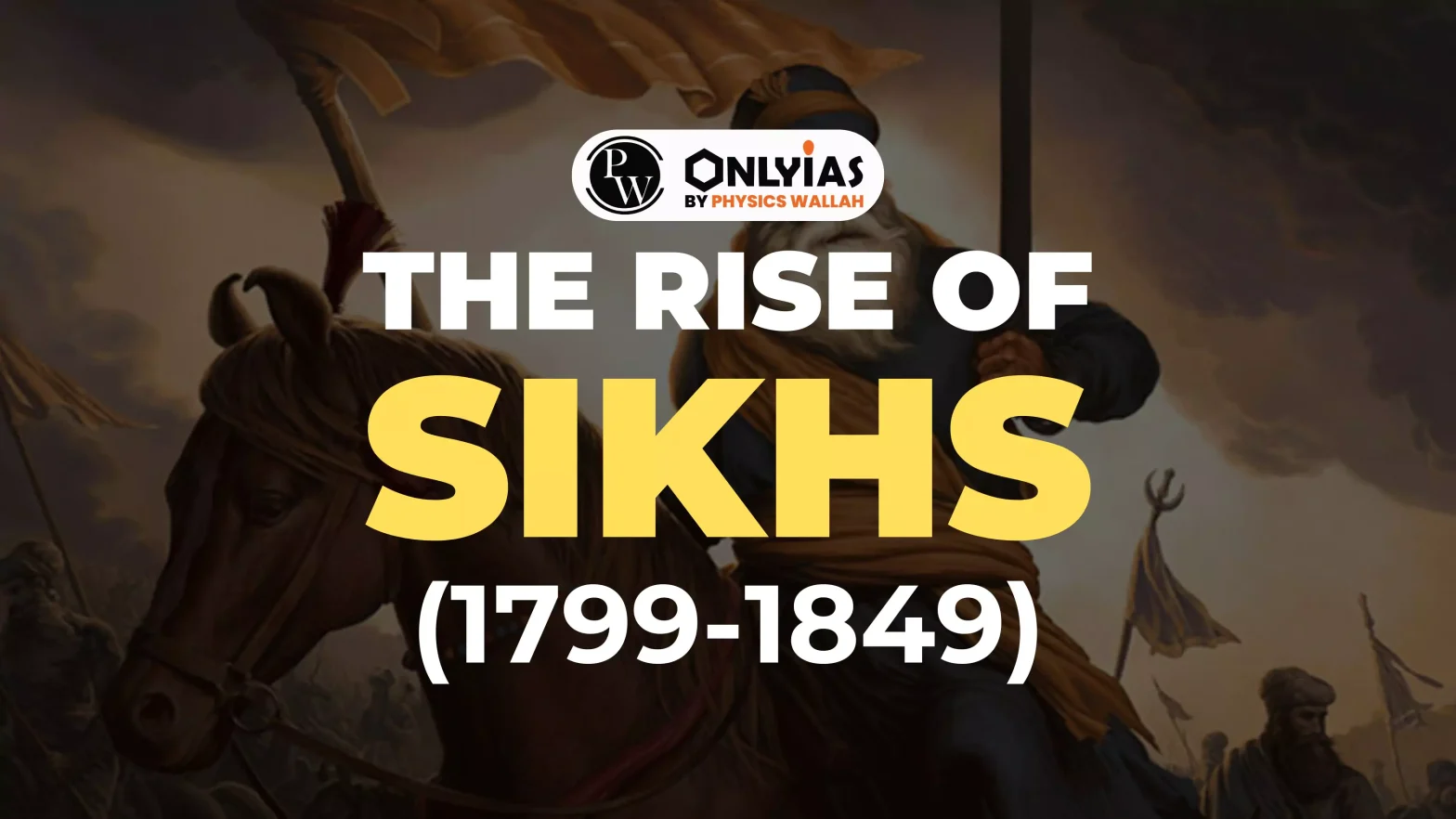
During the late 15th century, Guru Nanak established the Sikh empire, which witnessed the conversion of Jat farmers and individuals from lower castes in Punjab to the Sikh religion. Guru Hargobind played a significant role in transforming the Sikhs into a combative and militant group from 1606 to 1645. However, it was under the leadership of Guru Gobind Singh, the tenth and final Guru of the Sikhs (1664-1708), that they emerged as a prominent political and military force.
The rise of the Sikhs as a military power was a result of their strong religious identity, the guidance of their Gurus. Following are the key points on the rise of Sikh as a military power:
|
#PWOnlyIAS Edge |
|
Maharaja Ranjit Singh (1780-1839)
|
The Sikh Empire, which reached its zenith under the rule of Maharaja Ranjit Singh in the early 19th century, had a distinct nature and administration that reflected the unique characteristics of the Sikh community. A brief account of their administration is given below:
|
List of 10 Sikh Gurus |
|
|---|---|
| 1. Guru Nanak (1469- 1539) | The First Sikh Guru, revered as the founder of Sikhism, introduced its teachings and principles, leaving a lasting spiritual legacy. |
| 2. Guru Angad Dev (1504-1552) | Guru Angad, the second Sikh Guru, compiled the writings of Guru Nanak and his own compositions in the Gurmukhi script, which became the exclusive medium for Sikh sacred texts, including the revered Guru Granth Sahib. |
| 3. Guru Amar Dass (1479-1574) | The third Sikh Guru played a pivotal role in fortifying the Sikh movement through the establishment of institutions such as Manjis and Piris, which served to strengthen and expand the Sikh community. |
| 4. Guru Ram Dass (1534-1581) | Being the fourth Sikh Guru, he established the groundwork for the sacred city of Amritsar, which subsequently evolved into the spiritual epicenter of the Sikh faith. |
| 5. Guru Arjun Dev (1563-1606) | As the fifth Sikh Guru and the son and successor of Guru Ram Dass, he constructed the Harmandar, widely known as the Golden Temple, and diligently compiled and enshrined the Holy Book, the Guru Granth, within its sacred premises. |
| 6. Guru Hargobind (1595-1644) | Being the sixth Sikh Guru, he constructed Akal Takhat, also referred to as the Throne of the Immortal, and designated it as the focal point of Sikh temporal power and authority. |
| 7. Guru Har Rai (1630-1661) | As the seventh Sikh Guru, he carried forward the mission initiated by his predecessors, diligently advancing the principles and teachings of Sikhism. |
| 8. Guru Har Kishan (1656-1664) | As the eighth Sikh Guru, he earned renown for his remarkable healing abilities, having cured smallpox-afflicted individuals in Delhi. His profound impact is acknowledged in the daily Sikh prayer, where he is revered as the alleviator of all miseries through his mere presence. |
| 9. Guru Teg Bahadur (1621-1675) | He was the 9th guru of Sikh who founded the town of Anandpur and was executed in Delhi by Aurangzeb for refusing to convert to Islam. He referred to himself as “Sachcha Badshah.” |
| 10. Guru Govind Singh (1666-1708) | The tenth and final Sikh Guru organized the Sikh community into a disciplined, martial order known as Khalsa (the pure). He introduced the five symbols of Sikhism, which include Kangha (comb), Kesh (long hair), Kada (iron bracelet), Kachcha (underwear), and Kirpan (sword or dagger). |
The rise of the Sikhs between 1799 and 1849 marked a transformative period in their history. From the establishment of the Sikh Empire under Maharaja Ranjit Singh to the consolidation of their political and military power, the Sikhs emerged as a prominent force in Punjab and beyond. With their roots in the teachings of Guru Nanak and the formation of the Khalsa, the Sikhs showcased resilience, religious identity, and military prowess. The administration under leaders like Ranjit Singh brought a delicate balance to Punjab’s governance, while the distinctive Sikh identity was strengthened through cultural resources and rituals. Overall, this era witnessed the rise of the Sikhs as a significant political and military power in the Indian subcontinent.

<div class="new-fform">
</div>